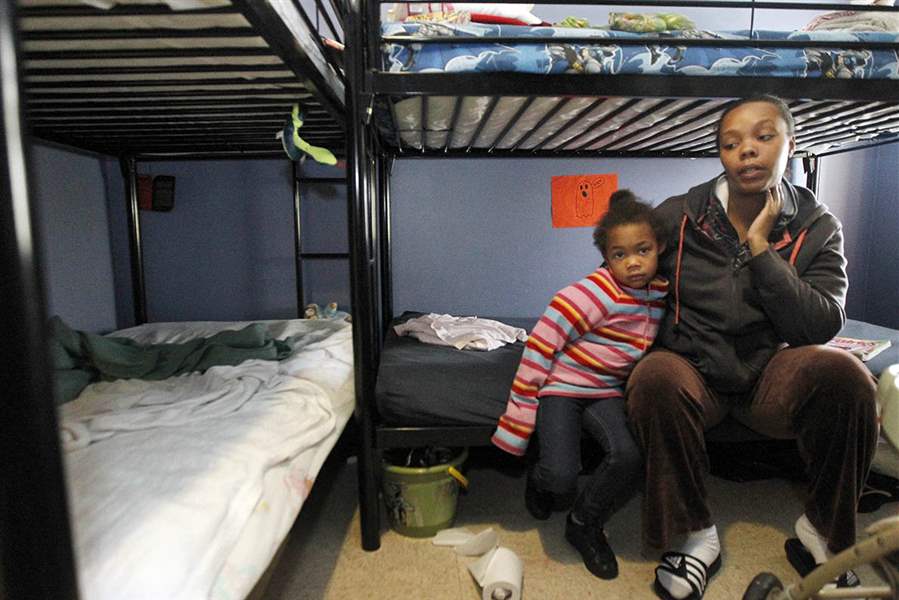
COMMENTARY
Fix problems in the 211 system, or scrap it
10/27/2013
Sasha Smith and her five children, including Makya, 4, have stayed at Family House shelter for six months, waiting for permanent housing.
THE BLADE
Buy This Image

Jeff Gerritt.
More than 20 years ago, the seminal rap group Public Enemy made “911 Is a Joke” an urban anthem. People knew that, in the hood at least, calling 911 was about as helpful as a hangman.
Now, Toledo’s 211 line that takes calls from the homeless has become a bad joke for some of the people who use it. Shelter directors call the new centralized intake system unresponsive, bureaucratic, and impractical.
Before this year, Toledo had a “no wrong door” policy. Homeless people would come to a shelter and either find help there or get sent to another spot that could house them. Since early this year, however, they have had to call United Way of Greater Toledo’s 211 line and answer questions before an operator can refer them to a shelter that has room.

Sasha Smith and her five children, including Makya, 4, have stayed at Family House shelter for six months, waiting for permanent housing.
Once they are in emergency shelter, clients are supposed to meet quickly with United Way housing specialists, funded by the Toledo Lucas County Homelessness Board, who assess their needs and try to place them in permanent housing. United Way gets $193,000 a year to provide these so-called coordinated assessment services. Previously, the shelters themselves placed people in permanent housing.
Since the new system started, complaints have been numerous, including reports of operators sending people to the wrong shelter. United Way housing specialists have been slow to assess and place people, forcing some shelters to continue doing that work despite hefty budget cuts.
“The 211 system is jacked,” Sasha Smith, a 26-year-old mother of five, told me last week. Ms. Smith and her kids have stayed at Family House shelter for six months, waiting for permanent housing.
Ms. Smith came to Family House in early June. She said she couldn’t get a United Way case worker to meet with her until September, after she threatened to take her complaints to the media.
I got a similar story from Regina White, 30, who came to Family House with her four children on Aug. 1. Families sit in emergency shelters longer now, advocates say.
“I’m tired,”’ Ms. White said. “I’m just going to find a place on my own. I won’t deal with this again, ever.”
Thomas Bonnington, the new executive director of the Toledo Lucas County Homelessness Board, told me last week that the new system has ended backlogs, but continues to get better, and could greatly improve services to homeless people.
He said a United Way specialist sees most families during the first week in a shelter, and usually within three or four days.
Mr. Bonnington acknowledged kinks, but vowed to fix problems. He noted that the system wasn’t fully up and running until Aug. 1, and said it already has lowered the number of people who return to homelessness.
Until now, homeless people who called 211 in Toledo at nights and on weekends talked to out-of-county operators in Napoleon, 40 miles away. Effective Nov. 1, however, all calls will be handled by local operators 24-7, Mr. Bonnington said.
Three weeks ago, I sat with a newly homeless family — a husband and wife with two children, ages 4 and 3 — in downtown Toledo. When the father called 211, an operator asked for his ZIP code, age, and date of birth, as well as his wife’s date of birth and the ages of their children.
He was also asked where he had stayed the previous night and how he had become homeless. After about 10 minutes on the phone, he was told that shelters were full and to call back tomorrow.
I learned the next week, however, that Family House shelter had a vacancy that same night that the family could have used. I don’t know how often mistakes like that happen, but even once is too often for people in crisis.
Defenders of the system, including Toledo Mayor Mike Bell, continue to suggest that mandates from the U.S. Department of Housing and Urban Development dictate the current system. Having interviewed HUD Secretary Shaun Donovan twice, I know that’s not true.
HUD wants data and coordinated services, but the department gives local communities flexibility in meeting its mandates. HUD is not ordering 211.
On the surface, it seems ridiculous to expect people who are cold or hot, hungry, and possibly mentally ill to call a number and answer questions from an impersonal-sounding operator before they can get help.
St. Paul’s Community Center, a shelter that serves many people with mental illnesses, installed a phone near its entrance so that staff members could help homeless people with 211 calls before they are admitted. Another shelter operator told me she sometimes ignores the 211 requirement when someone comes to her in immediate need.
“We don’t think that’s the right way to treat people,” she said.
In theory at least, the new system should work, enabling operators to give people up-to-date and complete information about shelter options in Toledo. Another plus: 211 is a 24/7 operation; not all shelters take people round-the-clock.
Too much is at stake to disrupt Toledo’s traditionally stellar homeless services. Working with shelter operators, the city’s next mayor must either fix the problems or find another way to house the homeless.
Nearly 1,000 people in Toledo are homeless at any given time, but 3,000 people are homeless at some time during the year. When I lived in Detroit, I would walk to my office at the Detroit Free Press and pass, every day, two or three homeless people sleeping on the sidewalks, even in January.
Unlike Detroit, where more than half of the city’s 20,000 homeless people live outside shelters — under bridges, in parks, inside vacant buildings — Toledo has few, if any, people living on the street.
But budget cuts and a still-stumbling 211 system, as well as lingering tensions between shelter operators — who mostly opposed 211 and centralized intake — and the city’s Department of Neighborhoods and the Homelessness Board threaten to undermine that progress.
Ken Leslie, a local homeless advocate and founder of Tent City, said the Homelessness Board has enough evidence to pull the plug on 211. “What will it take for them to realize it’s not working well?” he asked me. “Does someone have to die on the street?”
Either way, Mr. Bonnington and the next mayor need to spend more time in the shelters, talking to shelter directors, staff, and homeless people to figure out what’s best for Toledo.
The board, city officials, and shelter operators should meet regularly, even weekly, until they regain trust in one another. Those meetings should take place inside the shelters, to remind everyone why they’re there.
It would be a shame if a system that has worked so well for so long became a bad joke for Toledo’s neediest residents.
Jeff Gerritt is deputy editorial page editor of The Blade.
Contact him at: jgerritt@theblade.com, 419-724-6467, or follow him on Twitter @jeffgerritt.